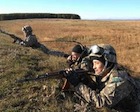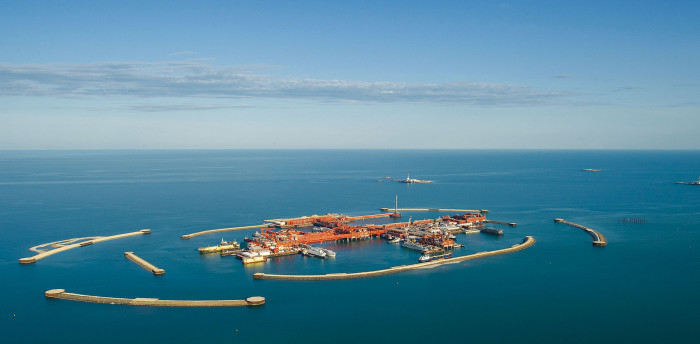 As part of Kazakhstan's bilateral defense cooperation with Russia, elements of their armed forces frequently participate in joint military exercises as well as within wider multilateral formats. Shygys 2011, June 20-29, staged in eastern and southeastern Kazakhstan, however featured innovations and raise important questions about the scenario and underlying defense planning, not least since a related air force exercise rehearsed repelling cruise missile attacks for the first time (Krasnaya Zvezda, June 25).
As part of Kazakhstan's bilateral defense cooperation with Russia, elements of their armed forces frequently participate in joint military exercises as well as within wider multilateral formats. Shygys 2011, June 20-29, staged in eastern and southeastern Kazakhstan, however featured innovations and raise important questions about the scenario and underlying defense planning, not least since a related air force exercise rehearsed repelling cruise missile attacks for the first time (Krasnaya Zvezda, June 25).
Shygys 2011 opened on June 20 reportedly involving 3,000 servicemen, 500 armored and other military vehicles and 30 aircraft. Units from Kazakhstan's air mobile forces in South Regional Command trained at the Matybulak and Koktal training ranges, with the air forces exercise (Vozdushnye Sily 2011) staged at the Kyzyl-Agash range in southeastern Kazakhstan, while the exercise at Semey was concluded on June 29 (Interfax, June 21).
In December 2010 in Moscow, Kazakhstan's Defense Minister Adilbek Dzhasybekov signed the cooperation plan for 2011 with his Russian counterpart, Anatoliy Serdyukov. Moscow and Astana agreed to hold three joint exercises (as in 2010), and discussed their themes: Russia would host Combat Commonwealth 2011 and the operational-strategic exercise Tsentr 2011, while Kazakhstan hosts the tactical command staff exercise Shygys 2011. Dzhasybekov emphasized that these exercises would "strengthen cooperation in regional security and defense and help counter terrorism and extremism" (ITAR-TASS, December 9, 2010). Since then the Arab Spring and western intervention in Libya may have subtly influenced the planning for Shygys 2011.
Notably, this exercise was distinctive in certain approaches, as well as the force elements involved, and not the typical "flash, bang wallop" to impress the generals. In addition to honing interaction in joint operations, careful attention was devoted to units functioning independently once deployed in the field. Kazakhstan was represented in the exercise by units from the East, South and Astana Regional Commands, air defense and air assault forces as well as a number of reservists. Russian participation involved elements from the Air Force (Voyenno Vozdushnye Sily –VVS), the elite Airborne Forces (Vozdushno Desantnye Voiska –VDV) and "task groups" from the Central Military District (MD). During military operations, the Russian MD's switch to joint strategic commands and Shygys may well have witnessed testing this and assessing how it works in practice (with the added complication of VDV placed under the command of the General Staff). Krasnaya Zvezda reported that Major-General Sergei Chubakin, the Deputy Chief of the Central MD was closely involved in the exercise, and no doubt attention was paid to VDV performance since independent Moscow-based assessments suggest its combat readiness has declined since the Russia-Georgia war in 2008 (Interfax, June 16; Krasnaya Zvezda, June 25; www.cast.ru/news/.
The official emblem of the exercise shown on Kazakhstan's defense ministry website makes it clear that Shygys 2011 was a bilateral exercise with no reference to the Collective Security Treaty Organization (CSTO). Nevertheless, the elite VDV and Kazakhstani air mobile forces assigned to the exercise are precisely those earmarked for the Collective Operational Reaction Forces (CORF) under the CSTO: the 31st Air Assault Brigade (VDV) and 37th Air Assault Brigade (air mobile forces) based in Taldykorgan (northeast of Almaty). On June 23, elite airborne units held live-fire practice at the Koktal training range. These air assault brigades are among the higher readiness forces in the armed forces of both countries, while the reported use of units from the Central MD suggest they function partly in support for Kazakhstani forces during any crisis erupting in Central Asia requiring a military response (Interfax, June 16, 20).
The most puzzling feature of the exercise occurred during Vozdushnye Sily 2011, part of the overall Shygys exercise, as the Russian and Kazakhstani Air Forces rehearsed various scenarios involving the violation of Kazakhstan's airspace by enemy aircraft, as well as for the first time, assigning the task of repelling a massive airstrike with "cruise missiles." In each case, all pretence was dropped that the exercise envisaged strengthening joint counter-terrorist capabilities: each vignette in the exercise scenario envisaged combat operations against forces from another state. Lieutenant-General Saken Zhassuzakov, the Chairman of Kazakhstan's Joint Chiefs of Staff outlined the cruise missile issue:
"For the first time, we have been working on repelling cruise missiles. We did not have such missions before. It is topical because the analysis made for the latest events happening in the world shows that the first strikes are the ones with cruise missiles, which can be fired from the range of one and a half, two and three thousand miles, and almost without the use of an aircraft. We have created a layered system of interception. The Taldykorgan aviation fleet also worked to capture these cruise missiles. We used Mig-31 aircraft from an airbase in Karaganda, which conducted the second interception on the second phase. We used the training aircraft L-39 from Balkhash for simulation purposes" (www.caspion.net, June 23).
The mission to intercept a cruise missile attack did not involve the VVS, and was carried out by Kazakhstani Air Force MiG-31 and Su-27 fighter aircraft (Krasnaya Zvezda, June 25; www.mod.gov.kz, June 23). There are numerous aspects to such "repelling cruise missiles" that are particularly puzzling. An analysis of "recent events" influencing the splicing of this aspect into the planned scenario fits the intervention against Gaddafi's forces in Libya by France, the UK and US forces, but is NATO intervention in eastern Kazakhstan even remotely plausible? The range factor is perplexing: at the upper limit of long-range cruise missile systems. Indeed, the location of this rehearsal suggests that the "hypothetical opponent" most likely has a much closer proximity. Moreover, there is an absence of any reported use of S-300 air defense systems, or S-400 (Moscow has deployed S-400 in Central MD as well as the East MD, en.rian.ru/russia/20080114/96525152.html).
Deterrent or counterforce strategies against enemy cruise missile capabilities demand advanced targeting and strike capabilities. Judging by Russian and Kazakhstani reporting the exercise used an interdiction/interception strategy which failed (no attacks on enemy assets) and as a default position was reduced to interception of cruise missiles using MiG-31/Su-27. Russian strategic bombers, Tu-22M3, were forward deployed to Taldykorgan, though their role was unspecified. While mystery surrounds the "hypothetical opponent" in the scenario that might launch such cruise missile attacks, the use of Taldykorgan may indicate that in an actual crisis necessitating CSTO involvement the base would be used for VVS platforms.
www.jamestown.org




